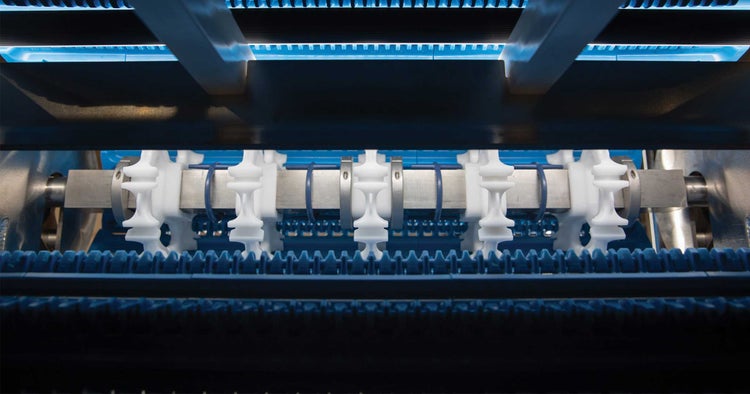Managing Labor Shortages in Food Processing
How to uphold food safety, quality, and efficiency standards with a limited workforce
- Insights
- February 9, 2022

Imagine you’re a racecar driver. You pull into the pit mid-race for a routine tire change and… half your pit crew is missing. Competitors whiz past while your limited-capacity team takes twice as long to do half as good of a job.
From manufacturing to retail, companies across the globe are trying to satisfy steady or increased demand for goods and services, while labor shortages threaten their ability to do so. Food processors are no exception. The COVID-19 pandemic has only exacerbated their long-standing struggle to hire and retain labor, and without sufficiently staffed “pit crews,” processors risk production delays, costly downtime, food safety concerns, and an increasingly dissatisfied workforce.
We spoke with our experts to better understand how food processors can reduce these risks and optimize production with a limited workforce.
Near Term: Find Quick Efficiency Wins
What can you do right now—even with your legacy equipment—to relieve some of the burden on your limited crew? Ask them!
Identify opportunities with team input
“Your plant is probably full of low-hanging fruit, ways you can make the job easier and faster for your workers. The best people to help you identify those quick wins are those closest to the problem,” says Dan Schmitz, Director of Operations for Commercial Food Sanitation. “Ask them what part of their job is the hardest. What tasks cause the greatest irritation or downtime? What obstacles can be most easily removed to free up time and resources?”
“Make sure your plant’s food safety team includes representatives from Quality, Production, Maintenance, and Sanitation,” Schmitz adds, “and ask that team to evaluate your legacy equipment against hygienic design checklists.”
Together with personal experience, they should be able to flag design problems and identify areas for improvement.
Embrace small upgrades with big impact
You may be surprised to learn that seemingly small annoyances can build to a large effect.
��“Take sprocket setup as an example,” says Kevin Guernsey, Global R&D Director of Intralox® FoodSafe™ Modular Plastic Products. “Some out-of-place sprockets on a single conveyor may not seem like a huge issue—you just have someone come reset them. But imagine the sprockets on every conveyor in your plant needing regular resetting, and suddenly the issue feels more significant. A simple upgrade to install sprocket spacers and retainer rings on a conveyor could eliminate that maintenance demand entirely for as little as $100."
Once you identify inefficiencies, lean on your partners to help identify simple fixes. It could be as easy as swapping out hollow rollers for solid rollers, installing belt lifters, or using a tool-free belt removal option like Intralox Clean Release.
Putting the right tools in the right hands can make your crew’s job easier and faster, in turn making labor constraints less felt plant-wide.

Conveyor Shaft Optimization prevents belt damage caused by sprocket migration with components designed to maximize conveyor performance.
Don’t underestimate the power of checklists
When a job isn’t done right—whether packaging a product, clearing a jam, or cleaning a belt—you can’t just forge ahead. Downtime drags as you try again.
Ensuring that your teams establish, train against, and adhere to proper protocols and sequencing can help eliminate redundancies while safeguarding operational efficiency and product quality.
Remember: Even if the size of your pit crew is limited, they’re faster when they work as a synchronized unit, with each team member doing exactly what’s expected exactly when expected.
Long Term: Future-Proofing Production
In the long run, the best way to combat labor shortages is to design a plant and process that need less human intervention. Select layouts, equipment, and materials that are easier to clean, break less often, and require less manual touch across Production, Maintenance, and Sanitation.
In other words, design a racecar that requires less frequent, less complicated pit stops.
While you probably can’t demolish your plant to start your design anew, you can prioritize these design principles as you replace or upgrade your equipment over time.
Intralox Team Tip: Making good hygienic design choices results in equipment that is easier and faster to clean.
Simplify sanitation
In food processing, sanitation crews are critical for ensuring high product quality and safety, but their job is often the hardest in the plant, with off hours and tough conditions. It’s a position that is both hard to hire and hard to retain.
Intentionally designing your conveyors to be easier to clean—from belt lifters to clean-in-place systems—makes a sanitor’s work not only more effective, but also more efficient, meaning a smaller sanitation team can more quickly cover more ground.
When automating parts of your operations, it’s tempting to focus solely on the production process, with little thought to how the equipment is going to be cleaned. Good hygienic design isn’t easy, but it can make a world of difference for sanitation workers and can establish a legacy of food safety at that plant.
Dan Schmitz
Director of Operations, Commercial Food Sanitation
As a bonus, anything that makes a sanitor’s job easier also makes it more likely they’ll stay with your company.
Train your own skilled labor
“There’s a tradeoff with automation,” says Guernsey. “As companies invest in technology to alleviate staffing pressures, they also have to invest in the necessary training to ensure their maintenance crew is well-equipped to service it.”
Leaning into partner-supplied training programs can help companies build expertise within their existing labor force, rather than trying to source from a limited supply of skilled laborers in the market.
Don't Go It Alone
This ongoing labor shortage will almost certainly force food processors to find innovative ways to optimize processes, simplify tasks, and equip plant workers to do more with less. Luckily, you’re not alone in doing so. From large-scale installations to small upgrades or process improvements, partners like Intralox stand ready to help you automate your operations where possible, reserving your people for the most critical touchpoints.
